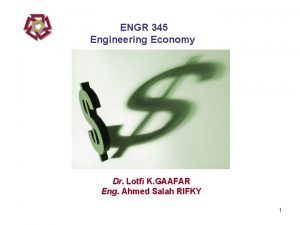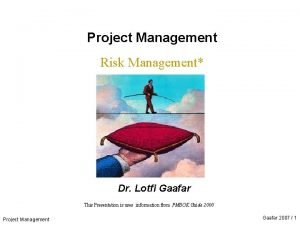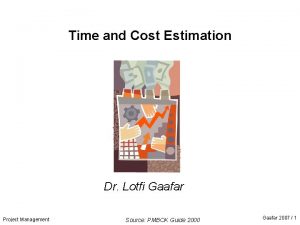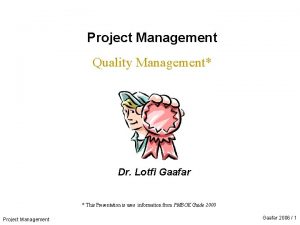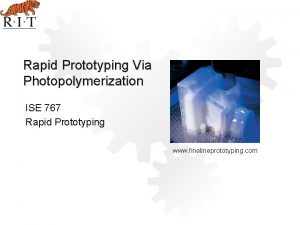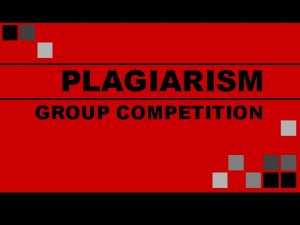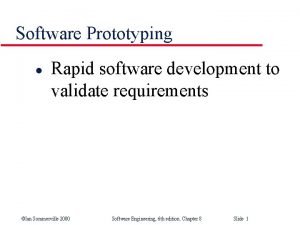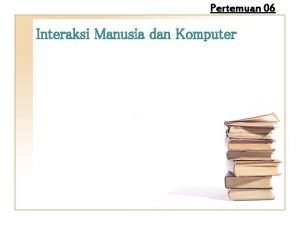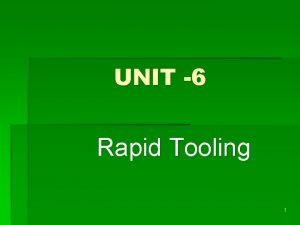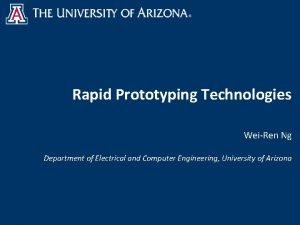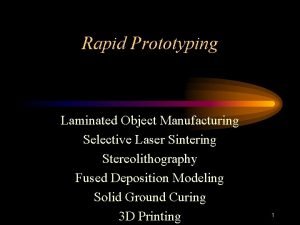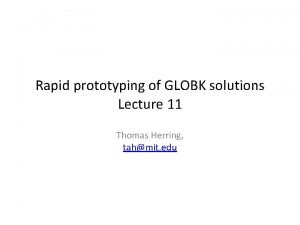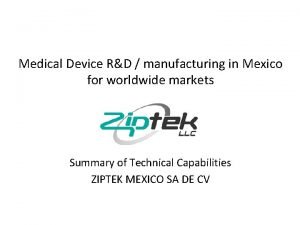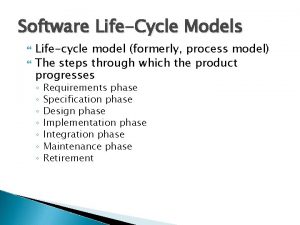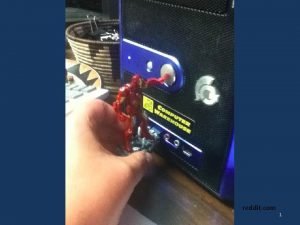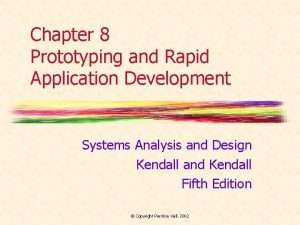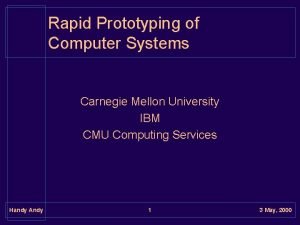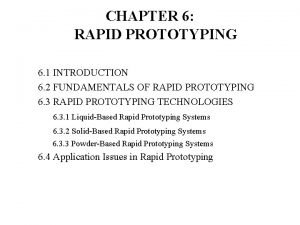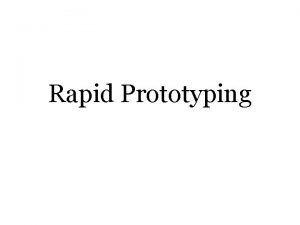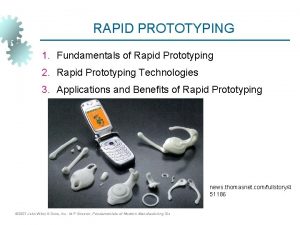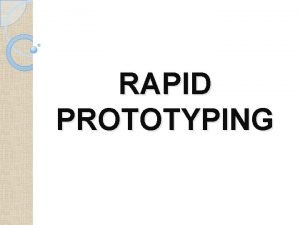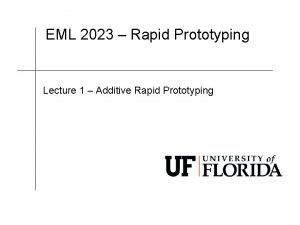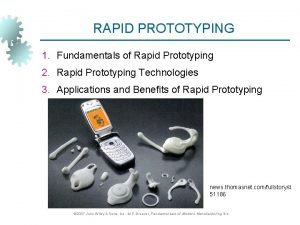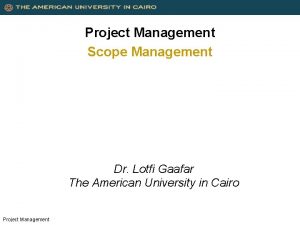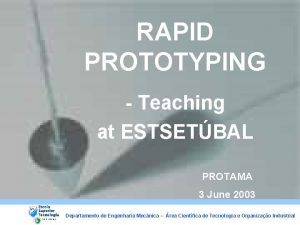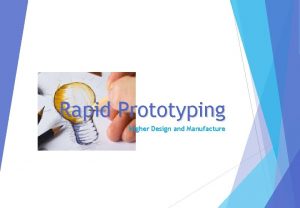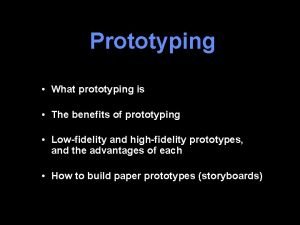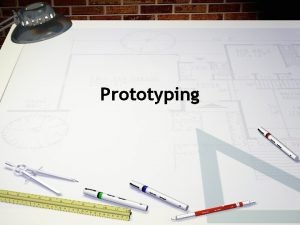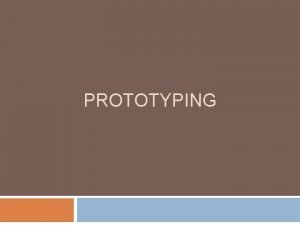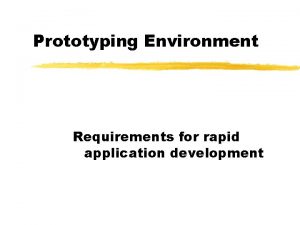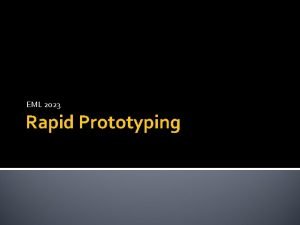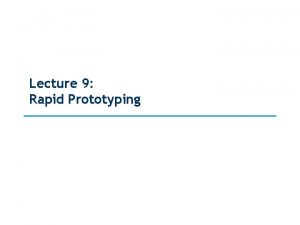Rapid Prototyping Dr Lotfi K Gaafar The American


























- Slides: 26

Rapid Prototyping Dr. Lotfi K. Gaafar The American University in Cairo Department of Mechanical Engineering gaafar@aucegypt. edu (202) 797 -5355 Dr. Lotfi K. Gaafar 2002

Introduction • Rapid Prototyping (RP) techniques are methods that allow designers to produce physical prototypes quickly. • It consists of various manufacturing processes by which a solid physical model of part is made directly from 3 D CAD model data without any special tooling. • The first commercial rapid prototyping process was brought on the market in 1987. • Nowadays, more than 30 different processes (not all commercialized) with high accuracy and a large choice of materials exist. • These processes are classified in different ways: by materials used, by energy used, by lighting of photopolymers, or by typical application range. Dr. Lotfi K. Gaafar 2002

The Rapid Prototyping Technique • In the Rapid Prototyping process the 3 D CAD data is sliced into thin cross sectional planes by a computer. • The cross sections are sent from the computer to the rapid prototyping machine which build the part layer by layer. • The first layer geometry is defined by the shape of the first cross sectional plane generated by the computer. • It is bonded to a starting base and additional layers are bonded on the top of the first shaped according to their respective cross sectional planes. • This process is repeated until the prototype is complete. Dr. Lotfi K. Gaafar 2002

Rapid Prototyping Technique • Process Flow 3 D Solid modeling Data preparation Part Building Pass Reject Redesign Dr. Lotfi K. Gaafar 2002

Prototyping- What is it ? . Physical Model of the product. Degrees of Prototyping. Full Complete scale Model - functional model. Scaled Model - functional/ simulated material. Geometrical configuration. Partial …. Dr. Lotfi K. Gaafar 2002

Prototyping- Why? Ù Visualization Ù Design Change (iterations) Ù Free Form Prototyping (complex object fabrication/ visualization) Ù Testing Fit/ Packaging Ù Cost, Time, and resource estimation Ù Process Planning Ù First to Market -- Critical for today’s industry Ù Rapid production (concurrent activities) Ù JIT concept (0 Inventory) Ù Rapid tooling / no tooling -- trend in technology Dr. Lotfi K. Gaafar 2002

Prototyping- Why? Design verification Ø Design for manufacturability Ø Design for assembly Ø Design for maintainability Ø Design for reliability Ø Design for Quality Ø Design Parameters (Tolerances/ allowances) Ù Concurrent Engineering Ù Tooling. Reverse Engineering. Die fabrication. Tool Path generation Ù Limited Production Dr. Lotfi K. Gaafar 2002

Classification of Prototyping Technology Ù Subtractive Processes (Material Removal) Ø Ex : Milling, turning, grinding, -- machining centers. . , when used for prototype production Ø Degree of automation vary Ù Additive (Material Build-up) Ø Ex : Stereolithography Ø Degree of sophistication vary Ù Formative (Sculpture) Ø Ex : Forging, Casting, . . Ø When used for Prototyping, it is usually manual Dr. Lotfi K. Gaafar 2002

Sophistication of Prototyping Technology Such Technology is known by different terms, such as : Ø Ø Ø Desktop Manufacturing Rapid Prototyping Tool-less Manufacturing 3 -D printing Free form Fabrication (F 3) Dr. Lotfi K. Gaafar 2002

Sophistication of Prototyping Technology Ù Fabrication process : The process must take a material in some shapeless form, and turn out solid objects with definite shape Ù Degree of Automation : High degree of automation. Since Prototyping is a stage in a cycle, it is expected that the technology will enable “automated chaining” to the before and after links in the cycle. Ù Ability to build complex objects The more complex the build object, the more sophistication in the technology. Dr. Lotfi K. Gaafar 2002

Sophistication of Prototyping Technology Ù Tooling (no Tooling): Less tools is better Ù One shot operations: No assembly of parts, . . etc. Ù Time: The less time the better it is Ù The closeness to serve the purpose of the prototype: Accurate representation of the design Ù Flexible: Modifications, addition of parameters, scaling Ù Equipment: size, weight, maintenance. . etc Ù Economical: Both equipment and operating costs Ù Clean, safe operation Ù User friendly Dr. Lotfi K. Gaafar 2002

Rapid Prototyping Processes Ù SLS --- Selective Laser Sintering Ù SLA --- Stereolithography Ù LOM --- Laminated Object Manufacturing Ù FDM --- Fused Deposition Modeling Ù Others Dr. Lotfi K. Gaafar 2002

Rapid prototyping Processes- SLS Selective Laser Sintering Dr. Lotfi K. Gaafar 2002

Rapid prototyping Processes- SLS Application Range Ø Visual Representation models Ø Functional and tough prototypes Ø cast metal parts Advantages Ø Flexibility of materials used ä PVC, Nylon, Sand for building sand casting cores, metal and investment casting wax. Ø No need to create a structure to support the part Ø Parts do not require any post curing except when ceramic is used. Disadvantages Ø During solidification, additional powder may be hardened at the border line. Ø The roughness is most visible when parts contain sloping (stepped) surfaces. Dr. Lotfi K. Gaafar 2002

Rapid prototyping Processes- SL Stereolithography Dr. Lotfi K. Gaafar 2002

Rapid Prototyping Resin Ù Basic Polymer Chemistry Ø SL Resin : It is a liquid photocurable resin ä Characteristics ä Fully 100% reactive component ä Energy efficient requiring 50 to 100 times less energy than thermally cured coatings Ø Polymerization : It is the process of linking small molecules (monomers) into larger molecules (polymers) comprised of many monomer units. Ø As polymerization occurs (chemical reaction) many properties changes, shear strength increase, density increased as resin changes from liquid to solid (shrinkage) Ø Polymerization occurs in SL through the exposure of liquid resin to laser. The layer thickness to be polymerized is given by the amount of liquid which has been recoated onto the part, and any excess laser radiation that penetrates this layer acts to slightly increase the curing of the previous layers. Ø The important properties for selecting the resin has to do with posture shrinkage and the resulting posture distortions. Dr. Lotfi K. Gaafar 2002

Desirable features of SL resin Ù Ù Ù Ù Improved Impact resistance (less brittleness) Greater Flexibility Improved photospeed Increased Strength Better overall part accuracy Electrical conductivity High temperature resistance Solvent resistance or vice versa Dr. Lotfi K. Gaafar 2002

Some measures to reduce distortions Ù Use high exposure and slow scan speed such that polymerization is essentially complete under the laser spot. Ù Use resin with a faster rate of polymerization Ù Decrease laser power to decrease scan speed for a given exposure. Ù Use low-shrinkage resin Ù Increase layer thickness to increase the strength Dr. Lotfi K. Gaafar 2002

Rapid prototyping Processes- SL Application Range Ø Parts used for functional tests Ø Manufacturing of medical models Ø Form –fit functions for assembly tests Advantages Ø Possibility of manufacturing parts which are impossible to be produced conventionally in a single process Ø Can be fully atomized and no supervision is required. Ø High Resolution Ø No geometric limitations Disadvantages Ø Necessity to have a support structure Ø Require labor for post processing and cleaning Dr. Lotfi K. Gaafar 2002

Rapid prototyping Processes- LOM Laminated Object Manufacturing Dr. Lotfi K. Gaafar 2002

Rapid prototyping Processes- LOM Application Range Ø Visual Representation models Ø Large Bulky models as sand casting patterns Advantages Ø Variety of organic and inorganic materials can be used ä Paper, plastic, ceramic, composite Ø Process is faster than other processes Ø No internal stress and undesirable deformations Ø LOM can deal with discontinuities, where objects are not closed completely Disadvantages Ø The stability of the object is bonded by the strength of the glued layers. Ø Parts with thin walls in the z direction can not be made using LOM Ø Hollow parts can not be built using LOM Dr. Lotfi K. Gaafar 2002

Rapid prototyping Processes- FDM Fused Deposition Modeling Dr. Lotfi K. Gaafar 2002

Rapid prototyping Processes- FDM Dr. Lotfi K. Gaafar 2002

Rapid prototyping Processes- FDM Application Range Ø Conceptual modeling Ø Fit, form applications and models for further manufacturing procedures Ø Investment casting and injection molding Advantages Ø Quick and cheap generation of models Ø There is no worry of exposure to toxic chemicals, lasers or a liquid chemical bath. Disadvantages Ø Restricted accuracy due to the shape of material used, wire is 1. 27 mm diameter. Dr. Lotfi K. Gaafar 2002

Rapid prototyping Processes • Other Processes • Ballistic Particle Manufacturing (BPM) • This process uses a 3 D solid model data to direct streams of material at a target. • 3 D Printing • It creates parts by layered printing process. The layers are produced by adding a layer of powder to the top of a piston and cylinder containing a powder bed and the part is being fabricated. • Model Maker • It uses ink jet printer technology with 2 heads. One deposits building material, and the other deposits supporting wax. Dr. Lotfi K. Gaafar 2002

Rapid Prototyping Products Dr. Lotfi K. Gaafar 2002
 Lotfi zad
Lotfi zad Lotfi gaafar
Lotfi gaafar Lotfi gaafar
Lotfi gaafar Project time & cost
Project time & cost Lotfi gaafar
Lotfi gaafar Fineline rapid prototyping
Fineline rapid prototyping Rapid prototyping could be an advantageous methodology
Rapid prototyping could be an advantageous methodology Rapid prototyping software engineering
Rapid prototyping software engineering Pengertian rapid prototyping
Pengertian rapid prototyping Polandball
Polandball Eml laser wikipedia
Eml laser wikipedia Rapid prototyping
Rapid prototyping Lom rapid prototyping
Lom rapid prototyping Rapid prototyping
Rapid prototyping Mexico rapid prototyping
Mexico rapid prototyping Synchronize and stabilize model
Synchronize and stabilize model Prototype 1 vs 2 reddit
Prototype 1 vs 2 reddit Prototyping and rapid application development
Prototyping and rapid application development Cmu rapid prototyping
Cmu rapid prototyping Introduction to rapid prototyping
Introduction to rapid prototyping Prototyping definition
Prototyping definition Liquid based rapid prototyping system
Liquid based rapid prototyping system Rapid prototyping rp
Rapid prototyping rp Méduce
Méduce Uf mae rapid prototyping
Uf mae rapid prototyping Prototyping methodology
Prototyping methodology Oem solid based rapid prototyping
Oem solid based rapid prototyping

